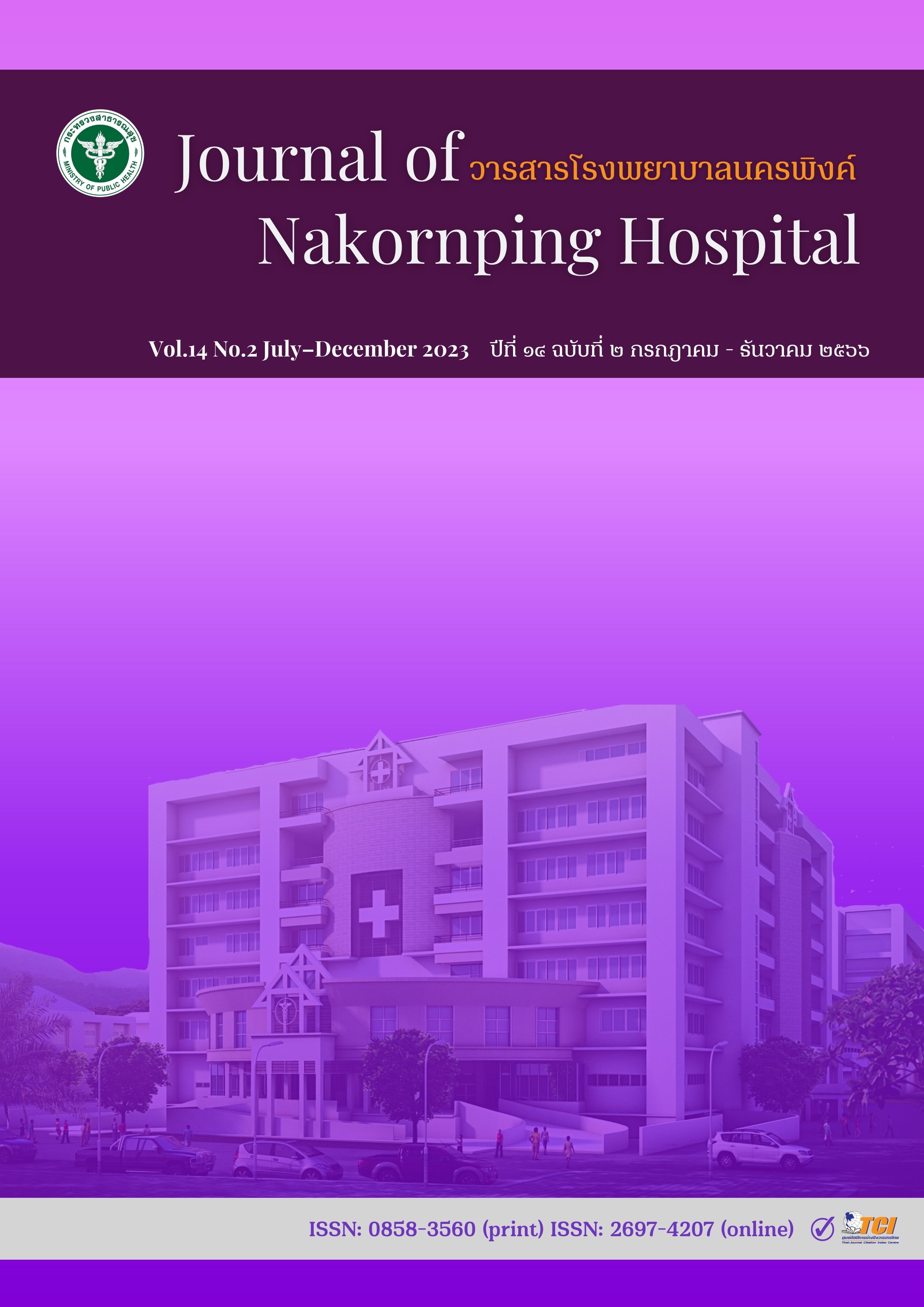Situation of unplanned extubation of patients admitted in medical intensive care unit
Keywords:
unplanned extubation, medical intensive care unit, incident, situation, complicationsAbstract
Background: Unplanned extubation is a significant problem in critically ill patients. Identification of the causes and related factors can empower nurses to prevent endotracheal tube dislodgement, safeguarding patient well-being.
Objectives: To investigate the incidence and circumstances surrounding unplanned extubation among patients admitted to the medical intensive care unit (MICU), Mahasarakham Hospital
Methods: This research was a retrospective descriptive design studying in all UE patients (26 cases) admitted in MICU of Mahasarakham Hospital between 1 December 2021 and 30 November 2022. The research tools utilized in this study for collecting data were the Situation of UE Recording Form, the Patient's Medical Record, and the Review Risks Record. Data were analyzed by using descriptive statistics.
Results: Of the total 853 patients who were intubated 26 had unplanned extubation , 80.77% male, 19.23% female, with average age of 62.88 + 16.60. Most of them had completed primary school (57.69%), were married (65.38%). Pneumonia was the most common diagnosis (69.23%). The incidence of UE was 7.53 times per 1,000 intubation days. Three factors happen in UE situations: 1) in patient factors, they had a good level of consciousness (96.15%). The majority of them moved and wiggled (80.77%), coughed a lot and irritated their throats (76.93%), and secreted a lot of saliva (57.69%); 2) in the nursing care and treatment factors, all patients had both arms restrained (100%), their hands tied loose (65.38%), they were on controlled ventilation mode, and they did not take sedative drugs (61.54%); and 3) in nursing personnel and management factors, the majority of the incidents of UE happened during the shifts of nurses who had never received specialized training in critical care patients (61.54%), in isolation rooms (57.69%), and during night shifts (42.31%). Following UE, the majority of them had abnormal vital signs and arrhythmias (69.23%) and experienced reintubation (65.38%).
Conclusion: In this study, the incidence of UE was found to be higher than the criteria. Patient factors, treatment and nursing care factors, and the experience of the personnel team are important in determining nursing development guidelines to prevent unplanned extubation.
References
Fujishima S. Guideline-based management of acute respiratory failure and acute respiratory distresssyndrome. J. Intensive Care. 2023; 11: 1-9. Available from: https://doi.org/10.1186/s40560-023-00658-3.
Şahiner Y. Indications for endotracheal intubation [Internet]. Tracheal Intubation. InTech; 2018. Available from: http://dx.doi.org/10.5772/intechopen.76172.
Tangman N. Intubation Situation and complications in Patients with Anesthesia, Udonthani Cancer Hospital. Journal Nursing Health and Education. 2020; 3(3): 13-9. [In Thai]
Hunprakop P, Surit P. Experiences of elderly people using mechanical ventilation in surgical intensive care units. Tertiary hospital. Journal of Nursing and therapeutic care. 2013; 31(4): 70-9. [In Thai]
Chaiweeradet M, Ua-Kit N, Oumtanee A. Experiences of being an adult patient receiving mechanical ventilator. Journal of Songkhlanagarind. 2013; 33(2): 31-46. [In Thai]
Pokathip S, Salakkhun P, Suttiprapa T, Datawee P, Kwanchang P, Sanaphrom N. Prevalence risk factor and nursing care of unplanned extubation: An Integrative review. Journal of Health Sci BCNSP. 2019; 3(3): 53-67. [In Thai]
Berkow L. Anesthesiology news airway management. New York: McMahon Publishing; 2019.
Abbas A, Lutfy SM. Incidence, risk factors, and consequences of unplanned extubation. Egypt J Chest Dis Tuberc. 2019; 68: 346-50. Available from: https://doi.org/10.4103/ejcdt.ejcdt_165_18
Mahmood SA, Mahmood OS, El-Menyar AA, Asim MM, Abdelbari AA, Chughtai TS, et al. Self-extubation in patients with traumatic head injury: determinants, complication, and outcomes. Anesth Essays Res. 2019;13: 589-95. Available from:https://doi.org/10.4103/aer.aer_92_19
Laverde-Sabogal CE, Espinosa-Almanza CE, Patino-Hernandez DP, Rodriguez-Escallon H, Aguado-Valderrama JC, Lara-Monsalve P. Risk factor of self-extubation in intensive care. Colombia J Anesth. 2023; 51:1-7. Available from: https://doi.org/10.5554/22562087.e1050.
Tanios M, Epstein S, Grzeskowiak M, Nguyen HM, Park H, Leo J. Influence of sedation strategies on unplanned extubation in a mixed intensive care unit. Am J Crit Care. 2014; 23: 306-15. Available from: https://doi.org/10.4037/ajcc20144446
Meksamut T, Sahmaae N, Khanbo K, Saelim K, Pasor A, Agasa R, et al. Developing nursing guidelines to prevent unplanned endotracheal tube removal in patients admitted to medical intensive care unit. J Princess of Naradhiwas university. 2023; 15(2): 15-33. [In Thai]
Quality improvement center. Risk profile statistical report. Mahasarakham: Mahasarakham Hospital. 2019. [In Thai]
Quality improvement center. Risk profile statistical report. Mahasarakham: Mahasarakham Hospital. 2020. [In Thai]
Quality improvement center. Risk profile statistical report. Mahasarakham: Mahasarakham Hospital. 2021. [In Thai]
Salakkhum P, Pokathip S, Chaoensri P, Wasombat O, Phumthong P, Saithong S, et al. Situation of unplanned extubationSanpasitthiprasong hospital. Journal of Medicine Sunpasitthiprasong Hospital. 2012; 40(1-3): 51-60. [In Thai]
Mohammed HM, Ali AA. Nursing issues of unplanned extubation in ICU. Int J Nurs Sci. 2018; 8:17-20. Available from : http://article.sapub.org/10.5923.j.nursing.20180802.01.html
Downloads
Published
How to Cite
Issue
Section
License
Copyright (c) 2023 Nakornping Hospital

This work is licensed under a Creative Commons Attribution-NonCommercial-NoDerivatives 4.0 International License.
The articles that had been published in the journal is copyright of Journal of Nakornping hospital, Chiang Mai.
Contents and comments in the articles in Journal of Nakornping hospital are at owner’s responsibilities that editor team may not totally agree with.



